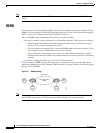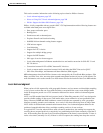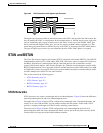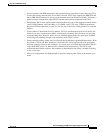
Overview of IBM Networking
RSRB
BC-202
Cisco IOS Bridging and IBM Networking Configuration Guide
78-11737-02
Note All commands supported on the Cisco 7500 series routers are also supported on the Cisco 7000 series
routers.
RSRB
In contrast to Source-Route Bridging (SRB), which involves bridging between Token Ring media only,
RSRB is a Cisco technique for connecting Token Ring networks over non-Token Ring network segments.
(DLSw+ is the Cisco strategic method for providing this function.)
The Cisco RSRB software implementation includes the following features:
• Provides for multiple routers separated by non-Token Ring segments. Three options are available:
–
Encapsulate the Token Ring traffic inside IP datagrams passed over a Transmission Control
Protocol (TCP) connection between two routers.
–
Use Fast-Sequenced Transport (FST) to transport RSRB packets to their peers without TCP or
User Datagram Protocol (UDP) header or processor overhead.
–
Use data link layer encapsulations over a single serial line, Ethernet, Token Ring, or Fiber
Distributed Data Interface (FDDI) ring connected between two routers attached to Token Ring
networks.
• Provides for configurable limits to the size of the TCP backup queue.
Figure 85 shows an RSRB topology. The virtual ring can extend across any non-Token Ring media
supported by RSRB, such as serial, Ethernet, FDDI, and WANs. The type of media you select determines
the way you set up RSRB.
Figure 85 RSRB Topology
Note If you bridge across Token Ring media, it is recommended that you do not use RSRB. Use SRB
instead. Refer to the chapter “Configuring Source-Route Bridging” for more information.
Token
Ring
Token
Ring
Token
Ring
Virtual ring
S2327
Token
Ring
Non-Token Ring
Media


















